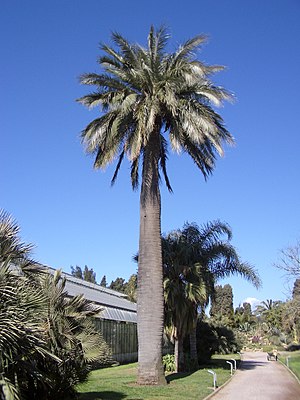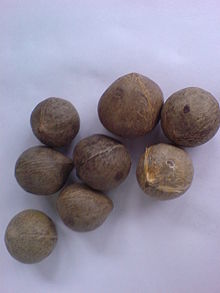Honey palm
| Honey palm | ||||||||||||
|---|---|---|---|---|---|---|---|---|---|---|---|---|

Honey palm ( Jubaea chilensis ) |
||||||||||||
| Systematics | ||||||||||||
|
||||||||||||
| Scientific name | ||||||||||||
| Jubaea chilensis | ||||||||||||
| ( Molina ) Baill. |
The Wine Palm ( Jubaea chilensis , Syn. : Jubaea spectabilis Kunth ) is one of Chile coming and there growing in Mediterranean-like climate palms art . It is the only species in the genus Jubaea .
description
The honey palm is a fiederblättrige (pinnate), monoecious getrenntgeschlechtige ( monoecious ) palm with a massive gray stem, up to 1.5 m for old specimens diameter and a height of 30 meters can reach. It has four to five meters long leaves. The inflorescences are up to 1.5 m long and have unisexual flowers . The fruits are three to four centimeters in size, green and when ripe yellow drupes , which contain a seed that looks like a small coconut and whose white, fleshy nutrient tissue ( endosperm ) also reminds of the smell and taste which is why they are called coquitos (dt. coconuts) in Chile .
use
The palm owes its German name to the sugary juice from which palm sugar , palm honey and palm wine are made. The palm tree has to be felled to obtain the sap, which is why its existence in its home is endangered and is now protected. It begins to bloom and bear fruit around the age of 60. The seeds of the fruit are used to make confectionery or as a snack.
Specialty
Jubaea chilensis is also planted in Europe: especially in the Mediterranean in southern France and northern Italy (there are two impressive specimens in the Botanical Garden of Pisa ), but also in South Tyrol (for example in the gardens of Trauttmansdorff Castle ), in Brittany and southern England.
The honey palm needs less summer heat than many other frost-tolerant palm trees, since the summers in their home country are not particularly hot. In contrast, it does not grow as well in humid, tropical climates. Because of its frost tolerance (planted specimens can withstand temperatures down to −15 ° C without major damage) and rarity, the Chilean honey palm is particularly popular with collectors in temperate latitudes.
Web links
- Jubaea chilensis inthe IUCN Red List of Threatened Species 2015.4. Posted by: González, 1998. Retrieved February 6, 2016.
- Growing and care instructions for the honey palm in the temperate zone
